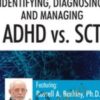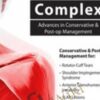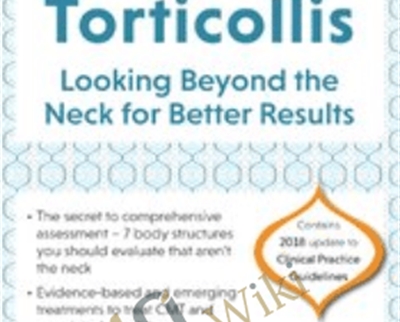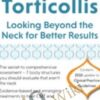$199.99 Original price was: $199.99.$75.00Current price is: $75.00.
7 Hours 30 Minutes
My name is Rosemary Peng, PT, MST. As a clinician who has worked for more than 20 years in pediatric settings, I’ve seen and treated patients with congenital muscular torticollis (CMT). In the past, I focused too much of my attention on treating the neck only and not checking for other asymmetries that can occur.
 Purchase this course you will earn 75 Points worth of $7.50
Purchase this course you will earn 75 Points worth of $7.50Elevate your skills with the Treating Torticollis: Looking Beyond the Neck for Better Results – Rosemary Peng course, available for just $199.99 Original price was: $199.99.$75.00Current price is: $75.00. on Utralist.com! Browse our curated selection of over 60,000 downloadable digital courses across diverse Uncategorized. Benefit from expert-led, self-paced instruction and save over 80%. Start learning smarter today!
My name is Rosemary Peng, PT, MST. As a clinician who has worked for more than 20 years in pediatric settings, I’ve seen and treated patients with congenital muscular torticollis (CMT). In the past, I focused too much of my attention on treating the neck only and not checking for other asymmetries that can occur. This resulted in seeing minimal gains. What was I missing? There had to be a better way to treat this population. Finally, I discovered that by including 7 body structures in my examination I could effectively treat my patients by strengthening neck muscles, promoting better head posture, and improving fine and gross motor development of the child.
In this recording, learn and practice evidence-based tools found in the updated 2018 Clinical Practice Guidelines which I use to accurately assess and treat infants. You’ll enhance your skills by learning proven treatment techniques as well as alternative approaches that don’t make your patient feel discomfort and results in better outcomes. Ease the fear of parents or caregivers with clear goals and education. Walk away feeling confident and comfortable using these proven strategies that immediately carry over into your clinical setting.
- Evaluate types and causes of infant torticollis and positional skull deformities.
- Demonstrate evidenced-based examination and treatment strategies for infants with CMT.
- List seven red flags that may warrant referral to a physician.
- Develop a plan of care using five components of first-choice interventions based on the Clinical Practice Guidelines (CPG).
- Examine emerging interventions that have not yet established efficacy.
- Create evidenced-based discharge planning, caregiver education, and recommendations for follow-up care.
TORTICOLLIS AND POSITIONAL SKULL DEFORMITIES – WHEN TO TREAT OR REFER
- Three types: Brachycephaly, plagiocephaly, scaphocephaly
- Craniosynostosis
- When and how to treat it
- When is it time for consultation with neurosurgery
HOW TO PROPERLY ASSESS A CHILD WITH CMT
- Posture
- Cervical range of motion: active and passive
- Muscle function scale for Infants
- Thoracic and lumbar spine
- Muscle flexibility of extremities
- Screen for developmental hip dysplasia
- Skin, facial, and skull asymmetries
- Visual motor skills: tracking, presence of nystagmus, midline control
- Classification of level of severity
EXAM LAB
HOW TO BEST TREAT CMT – LOOKING BEYOND THE NECK
- Cervical PROM
- Addressing other asymmetries below the neck
- Positioning
- Incorporate play into treatment
- Strengthening
- Addressing vision
- Why and how we address fine and gross motor skills
- Tummy time challenges
- Adapting the environment
- Caregiver education
INTERVENTION LAB
OTHER THERAPEUTIC APPROACHES FOR CMT
- Microcurrent
- Myokinetic stretching
- Kinesiological taping
- TAMO approach
- TOT and other collars
- Botox
- Surgery
EMERGING INTERVENTIONS WITHOUT EVIDENCE OF EFFICACY
- Manual therapy/cervical manipulation
- Craniosacral therapy
- Soft tissue massage
- Feldenkrais
- Total Motion Release
WHEN TO REFER FOR CONSULTATION
- 7 Red flags that indicate the need for referral to MDs
HOW TO IMPROVE YOUR GOAL WRITING
- Symmetrical movement
- Motor development
- Parent/caregiver understanding
DISCHARGE PLANNING AND FOLLOW-UP RECOMMENDATIONS
- Criteria for discharge
- Parent/caregiver understanding
- Follow-up screening recommendations
CASE EXAMPLES
Tag: Treating Torticollis: Looking Beyond the Neck for Better Results – Rosemary Peng Review. Treating Torticollis: Looking Beyond the Neck for Better Results – Rosemary Peng download. Treating Torticollis: Looking Beyond the Neck for Better Results – Rosemary Peng discount.
Cultivate continuous growth with the Treating Torticollis: Looking Beyond the Neck for Better Results – Rosemary Peng course at Utralist.com! Unlock lifetime access to premium digital content, meticulously designed for both career advancement and personal enrichment.
- Lifetime Access: Enjoy limitless access to your purchased courses.
- Exceptional Value: Benefit from savings up to 80% on high-quality courses.
- Secure Transactions: Your payments are always safe and protected.
- Practical Application: Gain real-world skills applicable to your goals.
- Instant Accessibility: Begin your learning journey immediately after buying.
- Device Compatible: Access your courses seamlessly on any device.
Transform your potential with Utralist.com!
Related products
Uncategorized
Managing Geriatric Behaviors: Wandering, Aggression, Malnutrition and More – Steven Atkinson
= 35 Points
Uncategorized
= 35 Points
Uncategorized
= 85 Points
Uncategorized
Disordered Eating Behaviors: Identify and Treat the Underlying Trauma – Lori Kucharski
= 85 Points
Uncategorized
= 85 Points
= 125 Points
= 94 Points
= 84 Points





